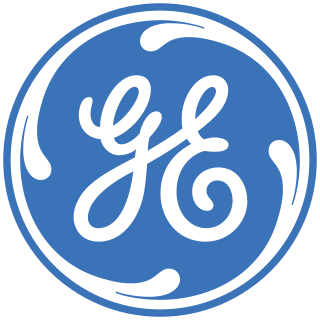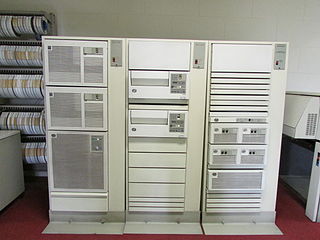Other
- 9000 Hal, an asteroid
- It's Over 9000!, an internet meme
9000 may refer to:
HAL 9000 is a fictional artificial intelligence character and the main antagonist in Arthur C. Clarke's Space Odyssey series. First appearing in the 1968 film 2001: A Space Odyssey, HAL is a sentient artificial general intelligence computer that controls the systems of the Discovery One spacecraft and interacts with the ship's astronaut crew. While part of HAL's hardware is shown toward the end of the film, he is mostly depicted as a camera lens containing a red and yellow dot, with such units located throughout the ship. HAL 9000 is voiced by Douglas Rain in the two feature film adaptations of the Space Odyssey series. HAL speaks in a soft, calm voice and a conversational manner, in contrast to the crewmen, David Bowman and Frank Poole.
IBM mainframes are large computer systems produced by IBM since 1952. During the 1960s and 1970s, IBM dominated the computer market with the 7000 series and the later System/360, followed by the System/370. Current mainframe computers in IBM's line of business computers are developments of the basic design of the System/360.

A mainframe computer, informally called a mainframe or big iron, is a computer used primarily by large organizations for critical applications like bulk data processing for tasks such as censuses, industry and consumer statistics, enterprise resource planning, and large-scale transaction processing. A mainframe computer is large but not as large as a supercomputer and has more processing power than some other classes of computers, such as minicomputers, servers, workstations, and personal computers. Most large-scale computer-system architectures were established in the 1960s, but they continue to evolve. Mainframe computers are often used as servers.

The IBM 704 is a large digital mainframe computer introduced by IBM in 1954. It was the first mass-produced computer with hardware for floating-point arithmetic. The IBM 704 Manual of operation states:
The type 704 Electronic Data-Processing Machine is a large-scale, high-speed electronic calculator controlled by an internally stored program of the single address type.

The IBM Series/1 is a 16-bit minicomputer, introduced in 1976, that in many respects competed with other minicomputers of the time, such as the PDP-11 from Digital Equipment Corporation and similar offerings from Data General and HP. The Series/1 was typically used to control and operate external electro-mechanical components while also allowing for primitive data storage and handling.

General Comprehensive Operating System is a family of operating systems oriented toward the 36-bit GE-600 series and Honeywell 6000 series mainframe computers.
HAL may refer to:

Amdahl Corporation was an information technology company which specialized in IBM mainframe-compatible computer products, some of which were regarded as supercomputers competing with those from Cray Research. Founded in 1970 by Gene Amdahl, a former IBM computer engineer best known as chief architect of System/360, it has been a wholly owned subsidiary of Fujitsu since 1997. The company was located in Sunnyvale, California.
FICON is the IBM proprietary name for the ANSI FC-SB-3 Single-Byte Command Code Sets-3 Mapping Protocol for Fibre Channel (FC) protocol. It is a FC layer 4 protocol used to map both IBM's antecedent channel-to-control-unit cabling infrastructure and protocol onto standard FC services and infrastructure. The topology is fabric utilizing FC switches or directors. Valid rates include 1, 2, 4, 8 and 16 Gigabit per second data rates at distances up to 100 km.
In computing, a Parallel Sysplex is a cluster of IBM mainframes acting together as a single system image with z/OS. Used for disaster recovery, Parallel Sysplex combines data sharing and parallel computing to allow a cluster of up to 32 systems to share a workload for high performance and high availability.

IBM Z is a family name used by IBM for all of its z/Architecture mainframe computers. In July 2017, with another generation of products, the official family was changed to IBM Z from IBM z Systems; the IBM Z family now includes the newest model, the IBM z16, as well as the z15, the z14, and the z13, the IBM zEnterprise models, the IBM System z10 models, the IBM System z9 models and IBM eServer zSeries models.
8000 may refer to:

The Univac Series 90 is an obsolete family of mainframe class computer systems from UNIVAC first introduced in 1973. The low end family members included the 90/25, 90/30 and 90/40 that ran the OS/3 operating system. The intermediate members of the family were the 90/60 and 90/70, while the 90/80, announced in 1976, was the high end system. The 90/60 through 90/80 systems all ran the Univac’s virtual memory operating system, VS/9.
The VAX 9000 is a discontinued family of mainframes developed and manufactured by Digital Equipment Corporation (DEC) using custom ECL-based processors implementing the VAX instruction set architecture (ISA). Equipped with optional vector processors, they were marketed into the supercomputer space as well. As with other VAX systems, they were sold with either the VMS or Ultrix operating systems.
Artemis is the brand name of a family of software based project planning and management tools.
The Input/Output Configuration Program is a program on IBM mainframes.

The IBM 9370 systems are "baby mainframe" midrange computers, released 1986 at the very low end of, and compatible with System/370. The media of the day, referring to the VAX systems manufactured by Digital Equipment Corporation (DEC), carried IBM's alleged "VAX Killer" phrase, albeit often skeptically.

The IBM 3090 family is a family of mainframe computers that was a high-end successor to the IBM System/370 series, and thus indirectly the successor to the IBM System/360 launched 25 years earlier.

The IBM System/390 is a discontinued mainframe product family implementing ESA/390, the fifth generation of the System/360 instruction set architecture. The first computers to use the ESA/390 were the Enterprise System/9000 (ES/9000) family, which were introduced in 1990. These were followed by the 9672, Multiprise, and Integrated Server families of System/390 in 1994–1999, using CMOS microprocessors. The ESA/390 succeeded ESA/370, used in the Enhanced 3090 and 4381 "E" models, and the System/370 architecture last used in the IBM 9370 low-end mainframe. ESA/390 was succeeded by the 64-bit z/Architecture in 2000.
9020 may refer to: